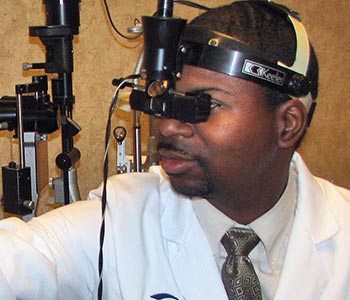Glaucoma
Pasadena Glaucoma Treatment
What is Glaucoma?
Glaucoma is often referred to as the “silent thief of sight” because most types typically cause no pain and produce no symptoms.
Glaucoma is usually, but not always, associated with elevated pressure in the eye. Generally, it is this elevated eye pressure that leads to damage of the optic nerve. In some cases, glaucoma may occur in the presence of normal eye pressure. Elevated pressure in the eye is the main factor leading to irreversible damage to the optic nerve and also affects the blood flow to the optic nerve resulting in a progressive, permanent loss of vision. However, early detection and treatment can slow or even halt the progression of the disease.

What is the Optic nerve and why is it important?
The optic nerve is similar to a fiber optic cable. This cable transmits information from the eye (the camera) to your brain (the control room) so you can see. If the nerve is damaged in any way and the small nerves are broken the information is not transmitted properly. If the nerve continues to be damaged then vision can be permanently lost.
How common is glaucoma?
Worldwide, glaucoma is the leading cause of irreversible blindness. In fact, as many as 6 million individuals are blind in both eyes from this disease. In the United States alone, according to one estimate, over 3 million people have glaucoma. As many as half of the individuals with glaucoma, however, may not know that they have the disease. The reason they are unaware is that glaucoma initially causes no symptoms, and the loss of vision on the side (periphery) is hardly noticeable.
Glaucoma Symptoms
Initially, there are no symptoms in open-angle glaucoma. The disease occurs slowly and no one really knows how fast it will progress. Many times patients first appear to the doctor after visual field loss has already occurred and now require constant medical attention to keep from losing the remaining visual field. Angle-closure glaucoma is rare but is more noticeable. The pressure in the eye increases rapidly and causes severe eye pain, blurred vision, and headache.
Who is at Risk?
Glaucoma mainly occurs in adults over the age of 40, but glaucoma can affect children also. Risk factors for glaucoma include a family history of the disease, African-Americans, Latinos, Asians, highly myopic (near-sighted) patients, and diabetic patients.

Normal Vision 
Glaucoma
Screening and Treatment

Screening for Glaucoma
Yearly examinations with your ophthalmologist will be sufficient to check for glaucoma. If you have any risk factors for glaucoma your ophthalmologist will perform a workup for glaucoma. The work-up includes testing your side (peripheral) vision, checking your eye pressure, checking for damage to the optic nerve, and checking for damage to the drainage system in the eye.
Treating Glaucoma
Glaucoma is usually treated with medications (eye drops). They work by decreasing the eye pressure by either decreasing fluid production in the eye or increasing outflow of fluid from the eye. If medical management is not controlling the eye pressure other treatment options are available. They include laser surgery and intraocular filtration surgery. Your doctor will decide which treatment option is right for you. While there is no cure as yet for glaucoma, early diagnosis and continuing treatment can preserve eyesight.








